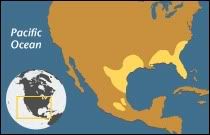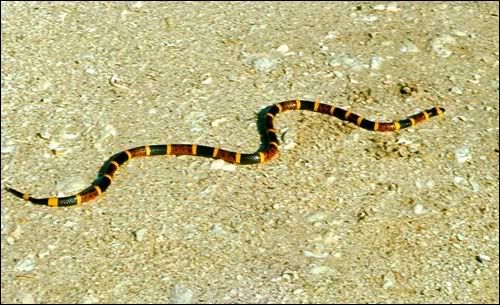|
|
Snake
Jul 22, 2009 15:41:24 GMT -5
Post by Revenge on Jul 22, 2009 15:41:24 GMT -5
Snakes
A Basic Body Plan: Snakes are found in almost all corners of the world except Antarctica. Snakes come in many shapes, sizes and colors, and their appearance reflects the environment in which they live. Without legs, eyelids and external ears, they have still evolved into formidable hunters.
Detecting Prey: Smell seems to be a snake's best asset. The snake analyzes scents by flicking its long tongue into the air to gather scent molecules, which are then transferred to the Jacobson's organ located inside its mouth. Some species, such as pit vipers, take advantage of organs on their face known as head pits to detect changes in temperature — another method that allows the snake to find its prey.
Killing Prey: Killing prey can take many forms. Some snakes use constriction. By wrapping its muscular body around its victim the snake can slowly suffocate and crush its prey. Snakes have extremely flexible jaws and can swallow prey that is much larger than their head. The digestive juices slowly kill the victim. Only about one in 10 snakes are venomous and within that group only a small proportion is a threat to humans.
Awesome Eyesight?: Most snakes have adequate eyesight, allowing them to track movements. The exception are arboreal (tree-dwelling) snakes, which have binocular vision. These snakes can focus both eyes on the same point in order to make a precise attack.
DID YOU KNOW?
Vomiting to Survive: Because their digestive process is so energy-consuming, snakes will often regurgitate food if threatened by a predator; otherwise, they'd be sitting ducks.
Species Small to Large: There are over 2,700 species of snake, ranging from 4 inches in length (the thread snake) to over 32 feet (the reticulated python).
Toothless Snakes: Egg-eating snakes are highly specialized species that lack teeth altogether. Instead, they have bony protrusions on the inside of their spine that break down egg shells after they've been eaten.
[/blockquote] |
|
|
|
Snake
Jul 22, 2009 15:43:48 GMT -5
Post by Revenge on Jul 22, 2009 15:43:48 GMT -5
The Eastern Coral Snake
Eastern Coral Snake Profile
A bite from the notoriously venomous eastern coral snake at first seems anticlimactic. There is little or no pain or swelling at the site of the bite, and other symptoms can be delayed for 12 hours. However, if untreated by antivenin, the neurotoxin begins to disrupt the connections between the brain and the muscles, causing slurred speech, double vision, and muscular paralysis, eventually ending in respiratory or cardiac failure.
This iconic snake, with its bulbous head and red, yellow, and black bands, is famous as much for its potent venom as for the many rhymes—"Red and yellow, kill a fellow; red and black, friend of Jack"—penned to distinguish it from similarly patterned, nonvenomous copycats, such as the scarlet king snake.
Coral snakes are extremely reclusive and generally bite humans only when handled or stepped on. They must literally chew on their victim to inject their venom fully, so most bites to humans don't result in death. In fact, no deaths from coral snake bites have been reported in the U.S. since an antivenin was released in 1967.
Eastern coral snakes are relatives of the cobra, mamba, and sea snake. They live in the wooded, sandy, and marshy areas of the southeastern United States, and spend most of their lives burrowed underground or in leaf piles.
They eat lizards, frogs, and smaller snakes, including other coral snakes. Baby snakes emerge from their eggs 7 inches (17.8 centimetes) long and fully venomous. Adults reach about 2 feet (0.6 meters) in length. Average lifespan in the wild is unknown, but they can live up to seven years in captivity.
Range (In the yellow)
Fast Facts
Type: Reptile
Diet: Carnivore
Average lifespan in captivity: Up to 7 years
Size: 20 to 30 in (51 to 76 cm)
Group name: Bed or knot
Did you know?: When threatened, a coral snake will curl the tip of its tail to confuse its attacker as to which end is its head.
Size relative to a 6-ft (2-m) man
|
|
|
|
Snake
Jul 22, 2009 15:55:09 GMT -5
Post by Revenge on Jul 22, 2009 15:55:09 GMT -5
The Eastern Diamondback Rattlesnake
Eastern Diamondback Rattlesnake Profile
The eastern diamondback rattlesnake is the largest venomous snake in North America. Some reach 8 feet (2.4 meters) in length and weigh up to 10 pounds (4.5 kilograms).
These stout-bodied pit vipers generally live in the dry, pine flatwoods, sandy woodlands, and coastal scrub habitats from southern North Carolina to Florida and west to Louisiana. Their pattern of yellow-bordered, light-centered black diamonds makes them among the most strikingly adorned of all North American reptiles. They are natural exterminators, surviving on such household pests as rats and mice, as well as squirrels and birds.
Feared as deadly and aggressive, diamondbacks are actually highly averse to human contact and only attack in defense. Most bites occur when humans taunt or try to capture or kill a rattlesnake. They can accurately strike at up to one-third their body length.
Diamondback venom is a potent hemotoxin that kills red blood cells and causes tissue damage. Bites are extremely painful and can be fatal to humans. However, antivenin is widely available throughout the snake's range, and bites rarely result in death.
When cornered, rattlers feverishly shake their iconic tails as a last warning to back off. Rattles are made of loosely attached, hard, hollow segments. Snakes add a new rattle segment each time they shed. However, rattles break off frequently, and snakes may shed their skin several times a year, so it is not possible to determine a snake's age by its rattle size.
The eastern diamondback is not endangered, but because of indiscriminate killing, widespread loss of habitat, and hunting, its numbers are decreasing throughout its range.
Range (In the yellow)
Fast Facts
Type: Reptile
Diet: Carnivore
Average lifespan in the wild: 10 to 20 years
Size: 5.5 ft (1.7 m)
Weight: 5 lbs (2.3 kg)
Did you know?: Baby rattlers can actually be more dangerous than adults because they have less control over the amount of venom they inject.
Size relative to a 6-ft (2-m) man
|
|
|
|
Snake
Jul 22, 2009 15:55:30 GMT -5
Post by Revenge on Jul 22, 2009 15:55:30 GMT -5
|
|








